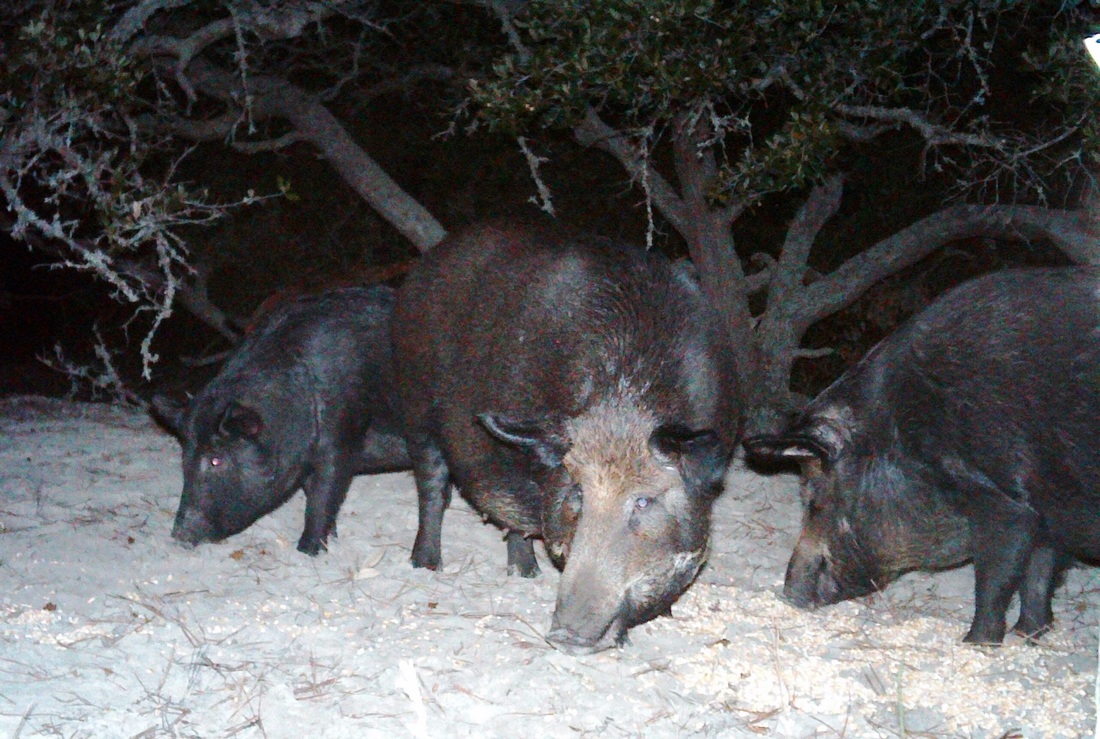 Feral hogs from the Back Bay population in southern Virginia Beach. Photo by David Bishop, USFWS.
Feral hogs from the Back Bay population in southern Virginia Beach. Photo by David Bishop, USFWS. Call them hogs, pigs, swine, razorbacks or Russian boars, by whatever name they go, the feral type of Sus scrofa poses an increasing threat to natural habitat and property in Virginia. This invasive species is a literal “reproductive machine that makes rabbits jealous,” according to DGIF’s (Department of Game and Inland Fisheries’) Aaron Proctor. So much so that Proctor has gone hog wild over wild hogs – he wants Master Naturalists to know how to spot feral hogs and learn to recognize their hoof prints and the damage they do, and then to report them if sighted. Time is of essence in controlling the species because a sow becomes fertile at five months of age and can produce approximately two litters of four to eight piglets a year. With few natural controls – coyotes and bobcats might prey on feral pigs, but only young ones less than six months of age and less than 60 lbs. – a new population can become a large one within a year. Adult feral hogs can mature at 200 to 300 lbs – that’s a lot of hog to go wild.
These feral beasts did not get here without help. Domesticated from Eurasian wild boars more than 9,000 years ago, pigs were brought to these shores by the explorers and colonists as domestic animals. Some inevitably escaped their pens and went wild, and even now some escape from “free range” pig farms. However, wild pigs are not migratory. Their populations slowly expand, but they do not travel long distances. Their explosion in recent decades in the Southeast and now in Virginia is due to the sad fact that most of these animals were released intentionally into public parks and private land for sport hunting. Biologists in Virginia have also noticed an increase in the number of loose hog populations whose freedom resulted from either poor fencing, poor oversight, or no fencing at all. Such loose domestic hogs can turn into a feral population in just a few generations. The last 20 years have seen wild pig ranges expand dramatically to include 45 states; Virginia is on the front lines of the northward spread of feral hogs in the East. The year 2010 saw a major increase of these feral beasts in Central Virginia – presumably due to loose domestics and introduction by game hunters.
When Tennessee decided in 1999 to allow a year-round season on hunting wild boar, the populations of feral pigs, contrary to all expectations, increased throughout the state. Instead of hunting being a means to control these pests, the open season encouraged hunters in a state with a solid wild-pig-hunting tradition to introduce hogs into areas where they had never before been seen.
Proctor says we cannot “manage” wild hogs, they must be “controlled”. And the best method of control is not hunting, but trapping. For control measures to make a dent in the population of an invasive species, 70% of the population must be eliminated each year – hunting and natural predation is not sufficient in the case of wild hogs. In 2014, a combination of federal and state funding resulted in approximately $330,000 in funding to combat feral hogs in Virginia, and expectations are that this funding will continue at least in the short term.
Pigs are indiscriminate – they will eat almost anything and will live in almost any habitat – farmland, forest, field, or flood plain. Although poor of eyesight, they have a keen sense of smell and can detect odors five to seven miles away and as much as 25 feet underground! Pigs go wild in the wilderness – they trample and uproot vegetation and root deeply in the soil, sometimes digging and wallowing to a depth of several feet. They eat corn and soybean crops, pine plantation seedlings, acorns, native wildflowers, saplings, ground-nesting birds, small mammals, worms, insects, larvae, even sea turtle eggs. These wild beasts destroy natural and built habitat, pollute watercourses with their feces, compete for food with wildlife – you name it, they do it. They are essentially a nightmare machine for disturbing habitat. They also harbor numerous diseases and parasites that can spread to domesticated pigs.
An admittedly conservative estimate of the cost of wild hog damage to agriculture and the environment in the United States is $1.5 billion annually. Rarely does a wild pig attack a human, but if a hunting dog corners a pig and the pig high-tails it through a pack of hunters, a person can be seriously injured. And as with bears, if a person inadvertently walks between a sow and her litter the sow is likely to react agressively to protect her young. Highly intelligent, wild hogs usually flee rather than fight. However, U.S. newspapers report from 5 to 7 human fatalities from wild hog encounters every year.
You can recognize these beasts in the wild by their signs: their cloven hoof prints, the troughs they dig with their snouts, the beds and nests they build, and even the rubs they leave on tree trunks and fence posts.
Defining Feral as a Nuisance
In Virginia, feral hogs have been classified as a nuisance species for quite some time (just like coyotes), so they can be hunted year-round. Although long-classified as a nuisance species, feral hogs lacked an official definition, making hunting them problematic because loose hogs might have owners. In 2014, the VDGIF attempted to remedy this situation by defining a feral hog as “any swine that are wild or for which no proof of ownership can be made.” This is a good step, but because Virginia law allows counties to set their own fence laws, some counties require a farmer to fence in their livestock to prevent escape, while other counties do not require farmers to fence livestock. Obviously, in counties where no fence is required, domestic or livestock swine can roam freely, reproduce, and proliferate without much human oversight. Without a fence to keep it out, a property owner cannot declare a trespassing pig a wild nuisance and hunt or trap it. This poses a huge problem for VDGIF and USDA biologists trying to control the growing feral hog problem in Virginia.
Master Naturalists Please Observe and Report
Master Naturalists can help by spreading the word to others about the destructive nature of feral hogs. The earlier the presence of wild pigs is detected and control measures begun, the better. Please immediately report any loose domestic (livestock) hogs or feral hogs you observe to the Virginia Wildlife Conflict Helpline at 1-855-571-9003 so they can be trapped and removed.
In addition, the public comment period for hunting and trapping regulations is now open until May 22. Among the proposed regulations is one mandating (1) the reporting of any trapped or harvested feral hogs, (2) requires any trapped feral hogs do not leave the trap site alive, and (3) that trapping be conducted only with landowner’s written permission. Citizens are invited to comment at https://www3.dgif.virginia.gov/web/comment-2015/display.asp.

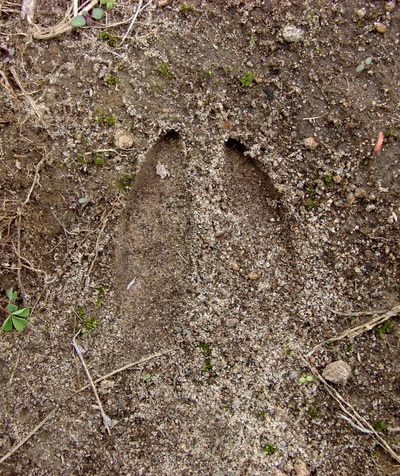
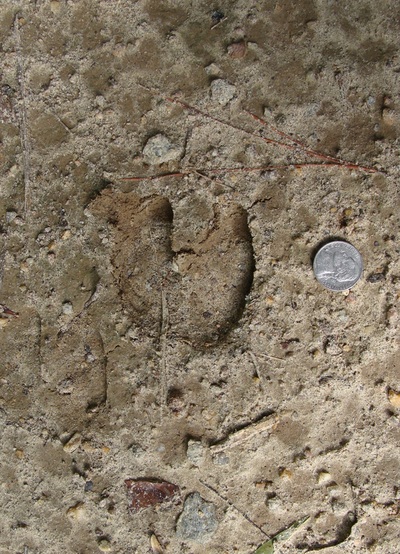
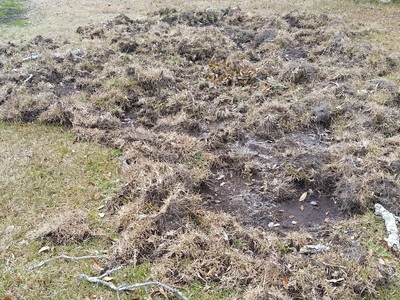
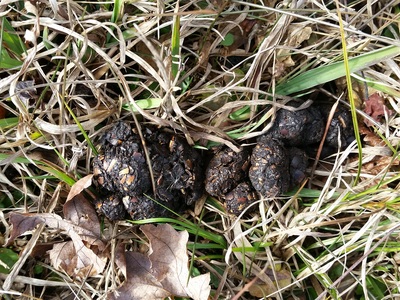

 RSS Feed
RSS Feed